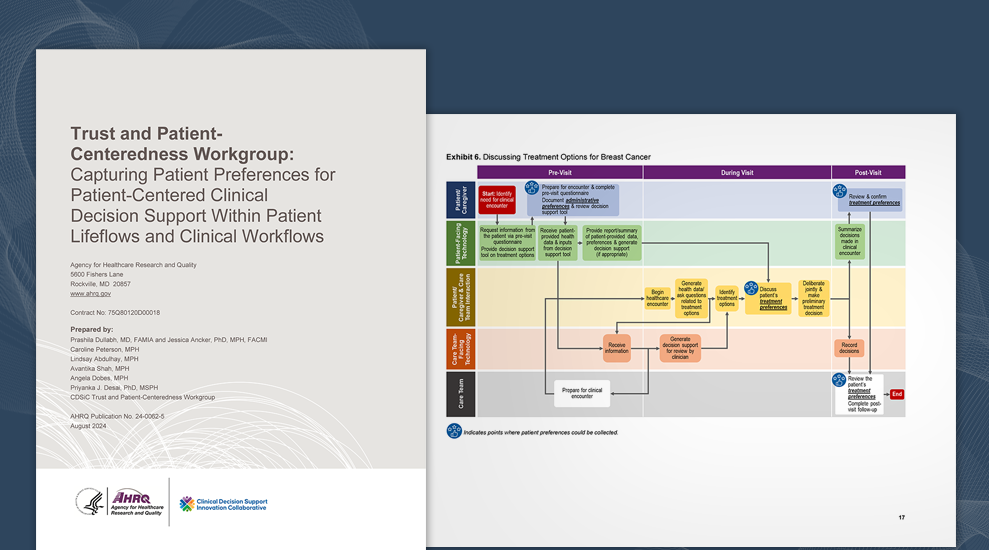
This report offers various methods for capturing different types of patient preference data and visualizes these within patient lifeflows and clinical workflows.
Developed by the AHRQ Clinical Decision Support Innovation Collaborative’s Trust and Patient-Centeredness Workgroup, this report identifies key considerations for optimizing the collection and use of patient preferences for patient-centered clinical decision support (PC CDS) to reduce patient and clinician burden, as well as opportunities to incorporate patient preferences into PC CDS.
Patients interact with the health system in different ways, presenting multiple opportunities for their preferences to be collected. These preferences can then influence the care they receive. The discussion and consideration of patient preferences in healthcare decision making can enhance patient satisfaction, improve health outcomes, promote patient autonomy, and support patient adherence to clinical recommendations. This report identifies opportunities to improve the collection and integration of patient preferences into PC CDS by ensuring these processes fit into clinicians’ workflows and patients’ lifeflows.
About the Report
Based on a literature review and a series of key informant interviews, this report describes when and how patient preference data are collected and includes a series of swimlane diagrams that visualize opportunities within patient lifeflows and clinical workflows for collecting and documenting patient preferences. These diagrams focus on four distinct clinical scenarios:
- Collecting administrative preferences before a clinical visit
- Collecting preferences related to health maintenance and preventive care
- Discussing medication therapy choices
- Discussing treatment options for breast cancer
Findings from our literature review and key informant interviews suggest there are several opportunities to improve the collection and integration of patient preferences into PC CDS by ensuring these processes fit into clinicians’ workflows and patients’ lifeflows. These include:
- Encouraging patients to provide preference information
- Gathering preferences that are important to patients’ care
- Delegating the collection of patient preference information to other care team members, such as medical assistants or nurses
- Ensuring patient preference data are easily accessible to clinicians
How To Use This Report
This report describes the timepoints and various methods for capturing different types of patient preference data, visualizes these within patient lifeflows and clinical workflows, and offers considerations to reduce patient and clinician burden. These considerations can be used by health system stakeholders and PC CDS developers seeking to optimize the collection and utilization of patient preference information for PC CDS.
Suggested Citation: Dullabh P, Ancker J, Peterson C, Abdulhay L, Shah A, Dobes A, Desai P, and the CDSiC Trust and Patient-Centeredness Workgroup: Capturing Patient Preferences for Patient-Centered Clinical Decision Support within Patient Lifeflows and Clinical Workflows. Prepared under Contract No. 75Q80120D00018. AHRQ Publication No. 24-0062-5. Rockville, MD: Agency for Healthcare Research and Quality; August 2024.





